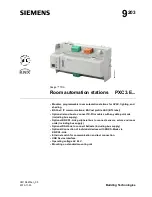
LampLinc Owner’s Manual
•
If the lamp being controlled by LampLinc already has its own built-in dimmer, turn that dimmer to
full-on and allow LampLinc to control the lamp’s brightness
•
To reduce the risk of overheating and possible damage to other equipment, use LampLinc to
control incandescent lamps only. Dimming an inductive load, such as a fan or transformer, could
cause damage to the dimmer, the load device, or both. If the manufacturer of the load device
does not recommend dimming, use a non-dimming INSTEON ApplianceLinc (#2456S) instead.
•
Don’t stack INSTEON home automation devices together by plugging them into one another.
Stacked modules may overheat and stop functioning.
•
Don’t use LampLinc to control devices that preserve, maintain, or contribute to human or animal
safety or life support
If you have any questions, please call:
INSTEON Gold Support Line
800-762-7845
Installing LampLinc
1) Plug the lamp/device (also called the load) you want to control into the
outlet on the
bottom
of LampLinc
2) Plug LampLinc into an unswitched wall outlet
The LampLinc Status LED and the load should turn on
3) If the load does not turn on, turn it on manually using the built-in switch
4) OPTIONAL: You can use the pass-through outlet on the
front
of
LampLinc as you would an ordinary uncontrolled wall outlet. However,
do not plug another home automation product into this outlet.
NOTE: After completing installation, you will not be able to use the load’s built-in switch to control the load
unless Load Sensing is enabled. See
Enabling/Disabling Load Sensing.
To control the load, you will need to Link LampLinc to an INSTEON Controller. You will not be able to
control the load from the LampLinc unit itself. See your Controller’s Owner’s Manual for detailed
instructions on how to control LampLinc.
Page 5 of 14



























